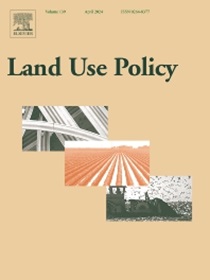规划做法是否阻碍了法国地中海城市周边地区的农场多样化?
IF 6
1区 社会学
Q1 ENVIRONMENTAL STUDIES
引用次数: 0
摘要
在空间规划与农业的交叉口,本文探讨了规划实践如何影响法国地中海城市周边地区的农场多样化战略。文章以农场建筑许可申请为重点,统计分析了数据库中 860 项建筑申请,并采访了地方当局和农民代表。结果显示,很大一部分申请与食品系统的再领土化、娱乐活动的开发和绿色能源的生产有关。这些农场多样化趋势凸显了城郊地区从自然景观或农业景观向多功能景观的转变,给规划带来了一些挑战。规划人员不知道如何评估新建筑是否真的对农业必不可少,也不知道如何找到正确的权衡办法,既支持农业发展,又限制土壤封存。他们的评估标准通常偏向于大型、全职和经济上可行的农场。比较两个省的规划实践,我们发现对国家法律的解释存在显著差异,尤其是在评估专业农业活动、新建住宅和太阳能项目时,采用的标准不一致或不协调。我们还强调了农民世代更新和农业生态或粮食转型的两个潜在障碍:i) 建筑许可评估背后的规则和决策过程缺乏透明度;ii) 多用途场所和轻型、移动或可拆卸结构的申请经常被拒绝。这些结果表明了规划者在改造城郊景观中的作用,以及需要对新农场建筑进行更加一致的管理,支持而不是阻碍农场适应战略和城郊地区的多功能性。本文章由计算机程序翻译,如有差异,请以英文原文为准。
Do planning practices hinder on-farm diversification in peri-urban Mediterranean France?
At the crossroads of spatial planning and agriculture, this article explores how planning practices impact on-farm diversification strategies in peri-urban Mediterranean France. It focuses on farm building permit applications, statistically analyzing a database of 860 buildings applied for and interviewing local authorities and farmers’ representatives. Results show the large proportion of applications related to reterritorialization of food systems, development of recreational activities, and production of green energy. These on-farm diversification trends highlight the transformation of peri-urban areas from a natural or agricultural landscape into a multifunctional landscape, posing several planning challenges. Planners don’t know how to assess whether a new building is really essential for farming, or to find the right trade-offs to support farming dynamics while limiting soil sealing. Their assessment criteria generally favor large, full-time, and economically viable farms. Comparing two provinces’ planning practices, we observe significant differences in interpretation of national law, with incoherent or unharmonized criteria applied especially when assessing professional farming activities, new dwellings, and solar energy projects. We also highlight two potential obstacles to farmers’ generational renewal and agroecological or food transitions: i) lack of transparency regarding the rules and the decision-making processes behind building permit assessment, and ii) the frequent rejection of applications for multi-purpose premises and lightweight, mobile, or dismantlable structures. Such results point to the role of planners in transforming peri-urban landscapes and the need for more consistent regulation of new farm buildings, supporting and not hindering farm adaptation strategies and the multifunctionality of peri-urban areas.
求助全文
通过发布文献求助,成功后即可免费获取论文全文。
去求助
来源期刊

Land Use Policy
ENVIRONMENTAL STUDIES-
CiteScore
13.70
自引率
8.50%
发文量
553
期刊介绍:
Land Use Policy is an international and interdisciplinary journal concerned with the social, economic, political, legal, physical and planning aspects of urban and rural land use.
Land Use Policy examines issues in geography, agriculture, forestry, irrigation, environmental conservation, housing, urban development and transport in both developed and developing countries through major refereed articles and shorter viewpoint pieces.
 求助内容:
求助内容: 应助结果提醒方式:
应助结果提醒方式:


